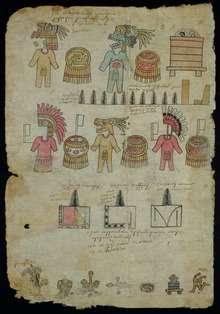Matrícula de Tributos

The Matrícula de Tributos (English: Tribute roll) is a 16th-century central Mexican manuscript on amatl paper, listing the tribute paid by the various tributaries of the Aztec empire.
Each page represents one province. The provinces totaled sixteen. Layout wise, the rolls are read from the bottom left up. The major city for the province is listed first. Further up the page there are tributes for cities that are under the rule of that major city. Each glyph shows an item that that town or city had use for tribute. It also keeps track of how many of what item were contributed in Nahuatl. Hernán Cortés had people make copies of the tribute roll in order to learn more about the Aztec economy. There are hundreds of tribute glyphs listed in it. It's considered an important document in learning about Nahuatl and Aztec culture, mathematics, governance, economy and geography. It is held in the collection of the Instituto Nacional de Antropología e Historia.[1]
The Matrícula was the source for the tribute section of the Codex Mendoza.
References
- ↑ "Tribute Roll". World Digital Library. Retrieved 21 January 2013.
